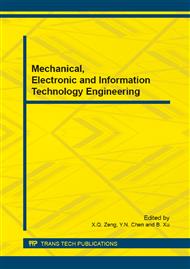p.359
p.365
p.373
p.379
p.385
p.390
p.395
p.399
p.403
Broadband Coherent Signal Direction Finding Algorithm Improvement
Abstract:
TCT for broadband coherent signal direction finding algorithm, the problem of large amount of calculation, an improved method of direction finding is studied, and the only focus signal subspace of the matrix is used to calculate, able to quickly estimate two-dimensional broadband coherent signal. Compared with the traditional TCT algorithm, in the case of without affecting the estimation precision greatly reduce amount of calculation and improve the signal DOA estimation of broadband real-time performance, and in an arbitrary planar array for the model computer simulation experiments have been carried out to verify the performance of it.
Info:
Periodical:
Pages:
385-389
Citation:
Online since:
March 2015
Keywords:
Price:
Сopyright:
© 2015 Trans Tech Publications Ltd. All Rights Reserved
Share:
Citation:


